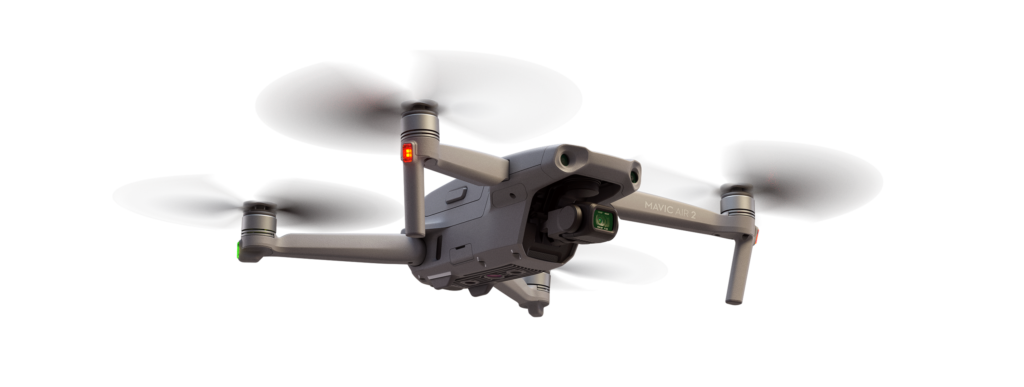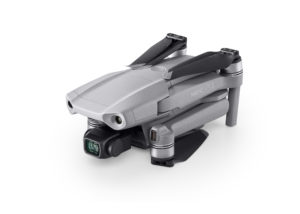 DJI’s Mavic Air 2 has been confirmed as the drone giant’s latest mid-range model.
DJI’s Mavic Air 2 has been confirmed as the drone giant’s latest mid-range model.
After months of anticipation (and a few leaks), the Chinese manufacturer officially announced the release of the Mavic Air 2, a folding quadcopter, on Monday night.
Featuring 8K functionality, the Mavic Air 2 sports a larger 1/2” camera sensor. The new model includes advanced programmed flight modes, intelligent features and imaging technology allowing beginners to capture professional-looking content.
In addition, the Mavic Air 2 boasts an enhanced maximum flight time and autonomous capabilities, as well as in-app editing functionality.
“Mavic Air 2 is another milestone for DJI, demonstrating that our smartest consumer drone does not have to be the largest,” DJI President Roger Luo said.
“While the Mavic Air 2 bears all the hallmarks of the Mavic drone family, we had to completely rethink its design and development process. Our goal was to create a drone that offered the best overall experience possible to even the most novice pilot. We hope our drones can help boost creativity and become a fun yet educational experience that can be enjoyed, even at this unprecedented moment in history.”
Due to COVID-related logistics issues, the Mavic Air 2 will be available for immediate purchase in China as of release Monday with preordering now available in other regions. Ship time is expected for mid-May. The base price is $799 (the drone, one battery, controller) with a Fly More option which includes all items from the standard version as well as a shoulder bag, ND filters, charging hub, and 3 batteries for $988.
Imagery
 Mavic Air 2 is the first drone in DJI’s Mavic series to offer 4K video at 60 fps and 120 Mbps. Pilots can also record content using HDR video (available at a max resolution of 4K 30), 4X Slow Motion in 1080p at 120 fps or 8X Slow Motion in 1080p at 240 fps. Pilots can chronicle 12-megapixel images (using advanced processing and pixel binning). The Mavic Air 2 will also offer a high-resolution 48-megapixel feature. A mechanical 3-axis gimbal will help compensate for camera shake “to create smooth and stable footage, even in unpredictable scenarios.”
Mavic Air 2 is the first drone in DJI’s Mavic series to offer 4K video at 60 fps and 120 Mbps. Pilots can also record content using HDR video (available at a max resolution of 4K 30), 4X Slow Motion in 1080p at 120 fps or 8X Slow Motion in 1080p at 240 fps. Pilots can chronicle 12-megapixel images (using advanced processing and pixel binning). The Mavic Air 2 will also offer a high-resolution 48-megapixel feature. A mechanical 3-axis gimbal will help compensate for camera shake “to create smooth and stable footage, even in unpredictable scenarios.”
The Mavic Air 2 will also take full advantage of a large Quad Bayer 1/2″ sensor and deploy a suite of image capture modes. SmartPhoto records 12-megapixel photos using advanced scene analysis and deep learning to automatically choose among three options:
- HDR photos: Automatically captures seven varying exposures of the same photograph, merging them together to intensify the image.
- Hyperlight: Designed for low-light scenarios, the option leverages the taking of multiple photographs and merges them to bring out a clear image with less noise.
- Scene Recognition: Recognizes five categories of scenes including sunsets, blue skies, grass, snow, and trees. The hardware optimizes settings with the highest degree of color, detail, and tones.
Flight Performance
 “Mavic Air 2 completely rebuilt the basics of drone flight to open up the skies for more exploration for everyone who is passionate about drone technology,” a DJI statement notes.
“Mavic Air 2 completely rebuilt the basics of drone flight to open up the skies for more exploration for everyone who is passionate about drone technology,” a DJI statement notes.
Weighing in at 1.26 pounds, the Mavic Air 2 has a new motor under the hood as well as new speed controllers (ESCs), enhanced battery technology and a design the company says will enable flight times of up to 34 minutes per charge.
DJI supercharged the OcuSync 2.0 transmission tech for the Mavic Air 2, to allow a stable HD video feed at a maximum distance of 6.2 miles. OcuSync 2.0 supports 2.4GHz and 5.8GHz frequency bands with an auto-switching feature to hop between the two based on signal strength. Anti-interference technology blocks unwanted signals, as well.
Safety
New to the Mavic Air 2 are obstacle sensors on the front and rear. The sensors warn pilots when the drone is too close to an object and can be programmed to avoid moving to close to it. The drone also sports additional sensors and auxiliary lights on the bottom that will enable smooth, automatic landing in difficult lighting. The Mavic Air 2 will also feature DJI’s GEO geofencing solution to help keep drones away from the high-risk locations, such as airports.
DJI is hailing the Mavic air 2’s Advanced Pilot Assistance System 3.0 as the “next level of autonomous flying.”
“When users enable APAS 3.0, as obstacles come into the drone’s path, Mavic Air 2 will create a new path around, under or over the object to avoid collision, giving pilots the confidence to fly in more complex situations while focusing on capturing their ideal images. Using 3D mapping, the updated version aids in smooth transitions and more fluid movements around objects even in highly complex environments.”
 The Mavic Air 2 is DJI’s first consumer drone to include AirSense technology. The platform provides enhanced safety by warning drone pilots of other aircraft nearby. The release is, the company says, in accordance with DJI’s 10-point Elevating Safety vision published last year.
The Mavic Air 2 is DJI’s first consumer drone to include AirSense technology. The platform provides enhanced safety by warning drone pilots of other aircraft nearby. The release is, the company says, in accordance with DJI’s 10-point Elevating Safety vision published last year.
AirSense uses ADS-B aviation tech to receive signals from nearby aircraft and displays location on the drone pilot’s control screen. As aircraft approach the drone, AirSense will warn the drone pilot with messages, sounds and vibrations.
The company notes:
“Due to supply chain shortages related to the coronavirus pandemic, Mavic Air 2 units equipped with AirSense ADS-B will initially only be available in North America. A version of Mavic Air 2 will be available outside of North America without ADS-B. The two models are identical in all other aspects such as flight and imaging performance.”
“DJI has an unwavering commitment to enhance drone safety with technology, and Mavic Air 2 implements yet another pioneering safety solution for drone operations,” said DJI Vice President of Policy & Legal Affairs Brendan Schulman. “Our ambitious commitment to installing ADS-B in our new product models means Mavic Air 2 will be the world’s largest single deployment of ADS-B receiver technology, fulfilling and furthering our vision as the industry’s leader on voluntary safety efforts.”
FocusTrack
The Mavic Air 2 ships with FocusTrack, an advanced tracking feature, offering three different capture modes:
- ActiveTrack 3.0: Users can select a subject for the Mavic Air 2 to automatically follow. On its third iteration, ActiveTrack uses mapping technology and flight-path algorithms to improve subject tracking and obstacle avoidance. It also has the ability to quickly re-engage the subject if it temporarily moves behind an object.
- Point of Interest 3.0: Allows a pilot to set an automated flight path around a specific subject. “The updated iteration improves surface recognition to better dynamically track subjects.”
- Spotlight 2.0: Found in professional DJI drones, Spotlight locks a subject in the frame while the user has free operation of the drone’s movement.
Other features
The Hyperlapse feature brings the visual appeal of timelapse but with the added element of the drone physically moving. With the release of the Mavic Air 2, Hyperlapse can be shot in a max resolution of 8K. However, 8K HyperLapse can only use the free and Waypoints flight modes. 8K and 1080p are available at launch and additional resolutions will be added at a later date.
Pilots can choose four flight modes including Free movement, Circle, CourseLock and WayPoints. The Mavic Air 2 ships with pre-programmed flight maneuvers known as QuickShots that optimizes the 3-axis mechanical gimbal and electronic image stabilization.
Jason is a longstanding contributor to DroneLife with an avid interest in all things tech. He focuses on anti-drone technologies and the public safety sector; police, fire, and search and rescue.
Beginning his career as a journalist in 1996, Jason has since written and edited thousands of engaging news articles, blog posts, press releases and online content.
Email Jason
TWITTER:@JasonPReagan
Subscribe to DroneLife here.







[…] word on national parks: When I received my first “big kid” drone – a DJI Mavic Air – I gleefully anticipated capturing gorgeous vistas of sunrises, mountain views and vibrant fall […]